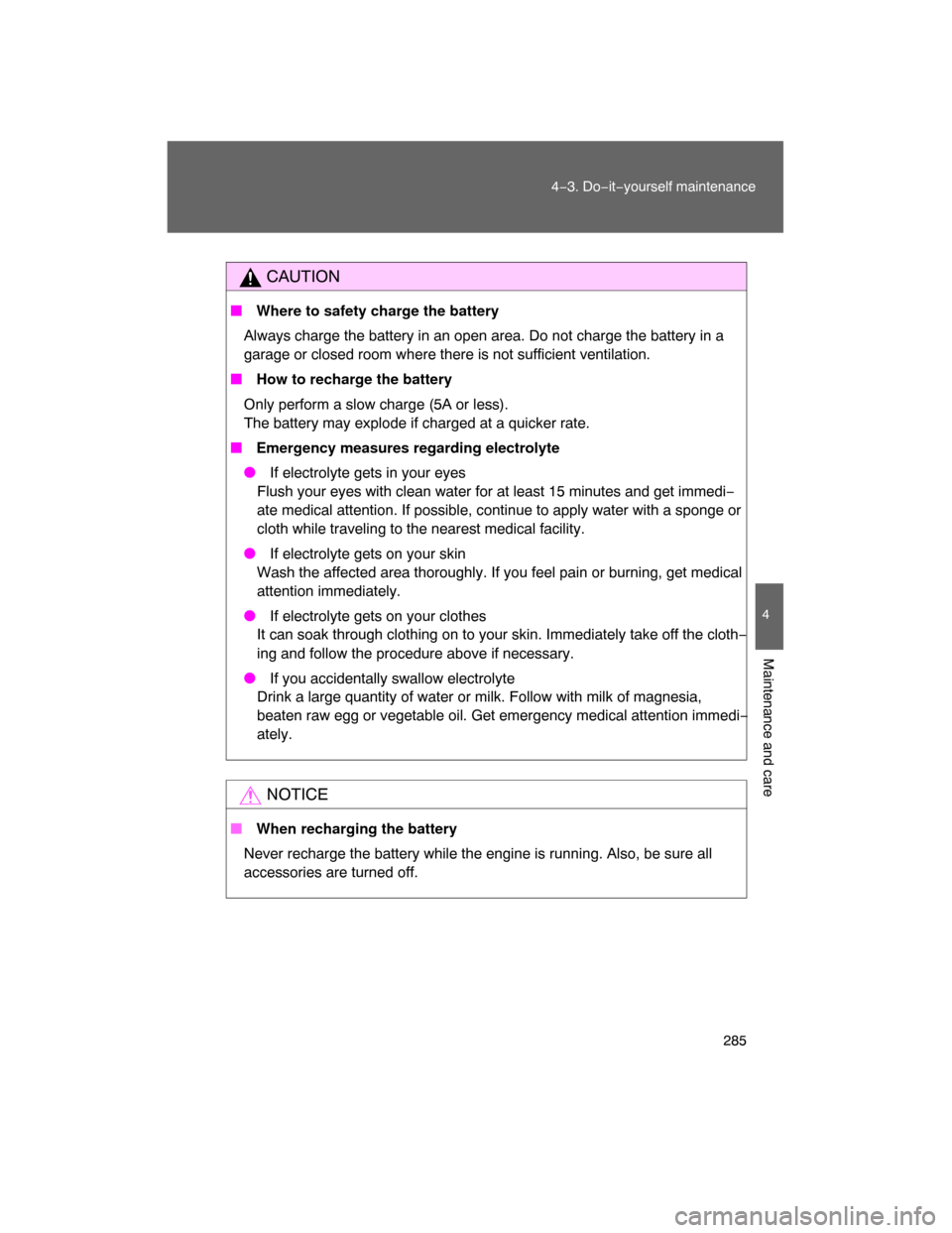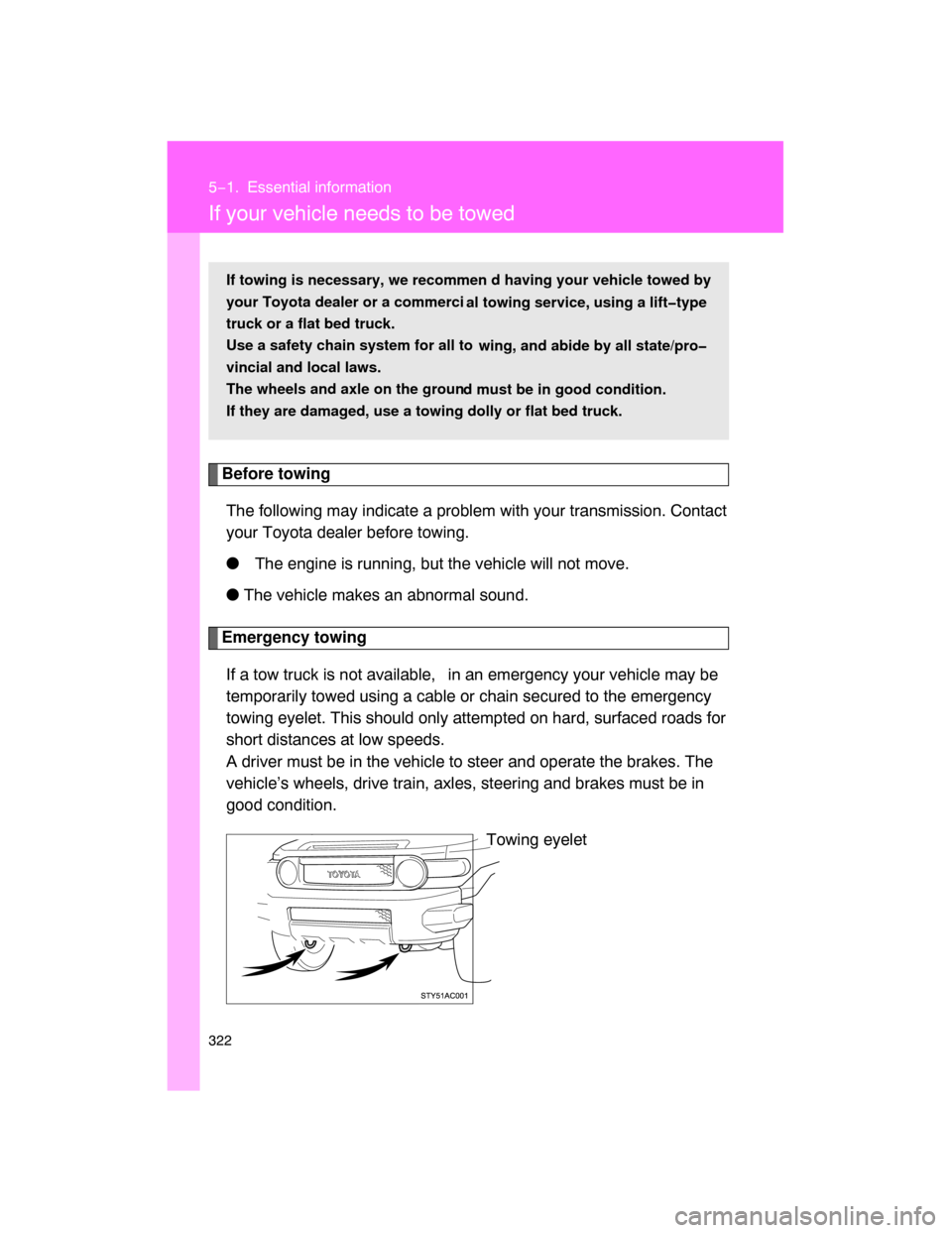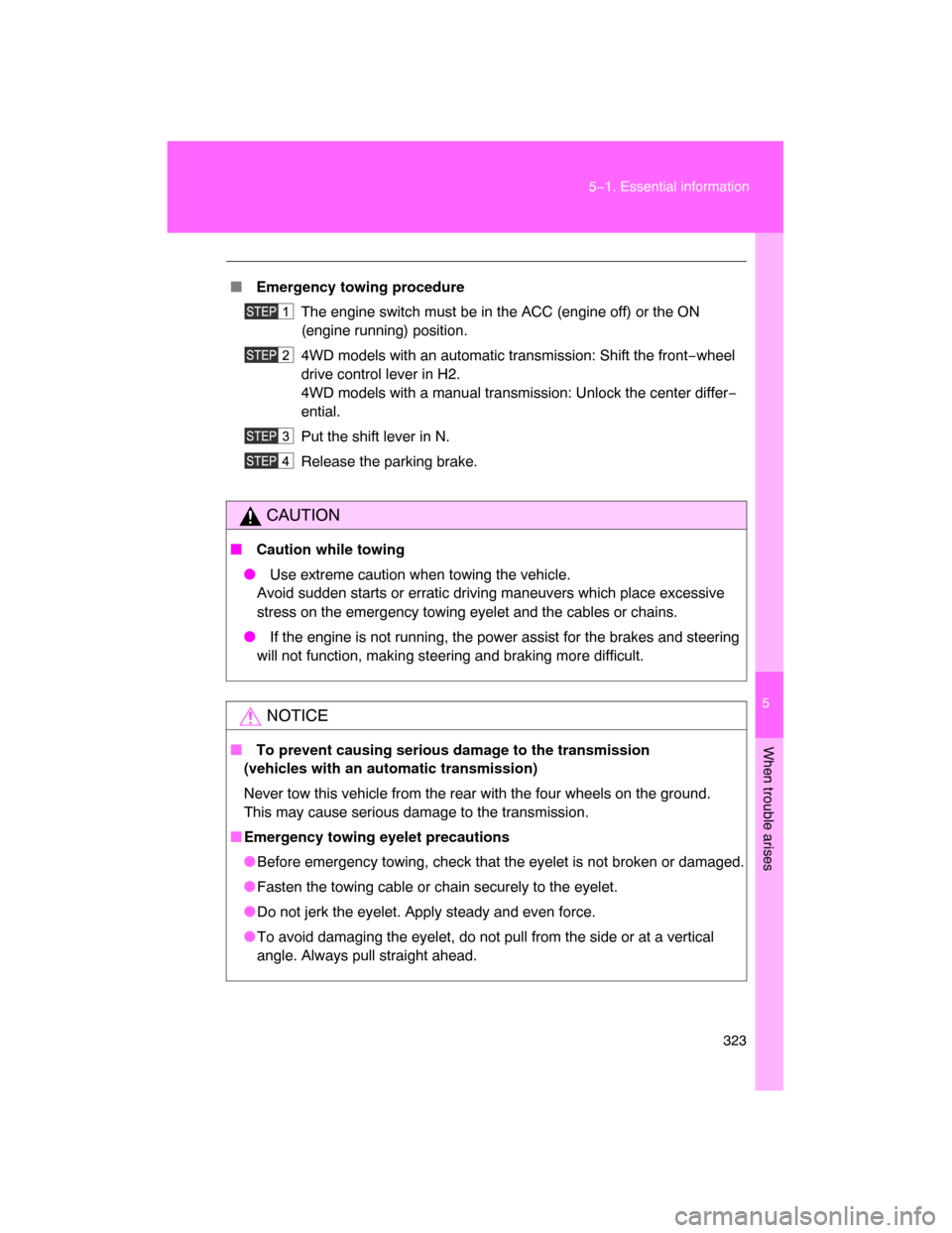Page 278 of 400
282 4−3. Do−it−yourself maintenance
Power steering fluid
� Fluid level
The fluid level should be within the appropriate range.
Full (when cold)
Add fluid (when cold)
Full (when hot)
Add fluid (when hot)
Hot: Vehicle has been driven around 50 mph (80 km/h) for 20
minutes, or slightly longer in frigid temperatures. (Fluid
temperature, 140°F − 175°F [60°C − 80°C])
Cold: Engine has not been run for about 5 hours. (Room tem−
perature, 50°F − 85°F[10°C − 30°C])
�
Checking the fluid level
Make sure to check the fluid type and prepare the necessary items.
Clean all dirt off the reservoir.
Remove the cap by turn
ing it counterclockwise.
Wipe the dipstick clean.
Reinstall and remove the reservoir cap again.
Check the fluid level.
Fluid type Automatic transmission fluid DEXRON® II or III
Items Rag or paper towel and funnel (only for adding fluid)
Page 281 of 400

285
4−3. Do−it−yourself maintenance
4
Maintenance and care
CAUTION
� Where to safety charge the battery
Always charge the battery in an open area. Do not charge the battery in a
garage or closed room where there is not sufficient ventilation.
� How to recharge the battery
Only perform a slow charge (5A or less).
The battery may explode if charged at a quicker rate.
� Emergency measures regarding electrolyte
� If electrolyte gets in your eyes
Flush your eyes with clean water for at least 15 minutes and get immedi−
ate medical attention. If possible, continue to apply water with a sponge or
cloth while traveling to the nearest medical facility.
� If electrolyte gets on your skin
Wash the affected area thoroughly. If you feel pain or burning, get medical
attention immediately.
� If electrolyte gets on your clothes
It can soak through clothing on to your skin. Immediately take off the cloth−
ing and follow the procedure above if necessary.
� If you accidentally swallow electrolyte
Drink a large quantity of water or milk. Follow with milk of magnesia,
beaten raw egg or vegetable oil. Get emergency medical attention immedi−
ately.
NOTICE
� When recharging the battery
Never recharge the battery while the engine is running. Also, be sure all
accessories are turned off.
Page 282 of 400
286 4−3. Do−it−yourself maintenance
Washer fluid
If any washer does not work, the washer tank may be empty.
Open the lid.
Add washer fluid.
NOTICE
� Do not use any fluid other than washer fluid
Do not use soapy water or engine antifreeze instead of washer fluid.
Doing so may cause streaking on the vehicle’s painted surfaces.
� Diluting washer fluid
Dilute washer fluid with water as necessary.
Refer to the freezing temperatures listed on the washer fluid tank.
Page 294 of 400
298
4−3. Do−it−yourself maintenance
Air conditioning filter
The air conditioning filter must be cleaned or changed regularly to
maintain air conditioning efficiency.
� Removal method
Turn the engine switch off.
Open the glove box.
Slide off the damper.
Push in each side of the glove
box to disconnect the claws.
Page 299 of 400
303
4−3. Do−it−yourself maintenance
4
Maintenance and care
Checking and replacing fuses
If any of the electrical componen ts do not operate, a fuse may have
blown. If this happens, check and replace the fuses as necessary.
Turn the engine switch off.
The fuses are located in the following places. To check the
fuses, follow the instructions below.
�
Engine compartment
Ty p e A
Push the tab in and lift the lid
off.
Type B (if equipped)
Push the tab in and lift the lid
off.
Page 303 of 400
307
4−3. Do−it−yourself maintenance
4
Maintenance and care
Fuse layout and amperage ratings
� Engine compartment
Ty p e A
Type B (if equipped)
3234
31 3016 17 1814
15 13
19 20 22 2321 24 25 2726
3328 29
5 4 367
2
8
9
10
12 11
1
Page 317 of 400

322
5−1. Essential information
If your vehicle needs to be towed
Before towing
The following may indicate a problem with your transmission. Contact
your Toyota dealer before towing.
� The engine is running, but the vehicle will not move.
�
The vehicle makes an abnormal sound.
Emergency towing
If a tow truck is not available, in an emergency your vehicle may be
temporarily towed using a cable or chain secured to the emergency
towing eyelet. This should only attempted on hard, surfaced roads for
short distances at low speeds.
A driver must be in the vehicle to steer and operate the brakes. The
vehicle’s wheels, drive train, axles, steering and brakes must be in
good condition.
Towing eyelet
If towing is necessary, we recommen d having your vehicle towed by
your Toyota dealer or a commerci
al towing service, using a lift�type
truck or a flat bed truck.
Use a safety chain system for all to
wing, and abide by all state/pro�
vincial and local laws.
The wheels and axle on the groun
d must be in good condition.
If they are damaged, use a towing dolly or flat bed truck.
Page 318 of 400

5
When trouble arises
323 5−1. Essential information
� Emergency towing procedure
The engine switch must be in the ACC (engine off) or the ON
(engine running) position.
4WD models with an automatic transmission: Shift the front−wheel
drive control lever in H2.
4WD models with a manual transmission: Unlock the center differ−
ential.
Put the shift lever in N.
Release the parking brake.
CAUTION
� Caution while towing
� Use extreme caution when towing the vehicle.
Avoid sudden starts or erratic driving maneuvers which place excessive
stress on the emergency towing eyelet and the cables or chains.
� If the engine is not running, the power assist for the brakes and steering
will not function, making steering and braking more difficult.
NOTICE
� To prevent causing serious damage to the transmission
(vehicles with an automatic transmission)
Never tow this vehicle from the rear with the four wheels on the ground.
This may cause serious damage to the transmission.
�Emergency towing eyelet precautions
�Before emergency towing, check that the eyelet is not broken or damaged.
�Fasten the towing cable or chain securely to the eyelet.
�Do not jerk the eyelet. Apply steady and even force.
�
To avoid damaging the eyelet, do not pull from the side or at a vertical
angle. Always pull straight ahead.